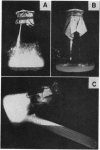Abstract
Two unknown bacterial isolants (C12 and C12B) were obtained from enriched soils and cultured on media containing detergent compounds as sole sources of carbon. Either isolant destroyed the foaming capacity of cultures containing dodecyl sulfate; but C12B, which could grow on dodecyl benzene sulfonate (DBS) whereas C12 could not, did not destroy the foaming capacity of this surfactant. The source of DBS available in quantity was a mixture of isomers derived from kerosene, and the bacteria utilized only one-fifth to one-fourth of this material during growth. Both isolants grew on short- or long-chained organic acids, and resting cells of both rapidly oxidized several long-chain acids and alcohols. Three of five phenyl-placement isomers of DBS (with the phenyl group at carbon 2, 3, or 6 on the alkyl chains) were excellent substrates for growth of C12B, but isomers with phenyl placement at carbon 4 or 5 were toxic and killed the bacteria.
Full text
PDF





Images in this article
Selected References
These references are in PubMed. This may not be the complete list of references from this article.
- FINCHER E. L., PAYNE W. J. Bacterial utilization of ether glycols. Appl Microbiol. 1962 Nov;10:542–547. doi: 10.1128/am.10.6.542-547.1962. [DOI] [PMC free article] [PubMed] [Google Scholar]



